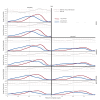Quadriceps and Hamstrings Activation Peaks Earlier as Athletes Repeatedly Hop, but There are Differences Depending on ACL Reconstruction Technique
- PMID: 38576837
- PMCID: PMC10987308
- DOI: 10.26603/001c.94610
Quadriceps and Hamstrings Activation Peaks Earlier as Athletes Repeatedly Hop, but There are Differences Depending on ACL Reconstruction Technique
Abstract
Background: After Anterior Cruciate Ligament Reconstruction (ACLR) athletes face the challenge of regaining their previous competitive level while avoiding re-injury and early knee joint cartilage degeneration. Quadriceps and hamstrings strength reductions and neuromuscular alterations potentially related to risk of re-injury are present after ACLR and relate to deficits in muscle activation.
Design: Cross-sectional laboratory study.
Purpose: To examine quadriceps and hamstrings muscle activation during repeated hops in healthy pivoting-sport athletes and those who had undergone ACLR (bone-tendon-bone and semitendinosus graft) who had met functional criteria allowing return to training.
Methods: Surface electromyography (SEMG) was recorded from vastus medialis and lateralis and medial and lateral hamstrings bilaterally during 30 seconds' repeated hopping in male athletes on average eight months after ACLR surgery (5-12 months). All patients underwent hamstring (HS) (n=24) or bone-tendon-bone (BTB) reconstruction (n=20) and were compared to healthy controls (n=31). The SEMG signals were normalized to those obtained during maximal voluntary isometric contraction.
Results: A significant time shift in peak muscle activation (earlier) was seen for: vastus medialis and vastus lateralis activation in the control group, in the BTB group's healthy (but not injured) leg and both legs of the HS group. A significant time shift in peak muscle activation was seen for lateral hamstrings (earlier) in all but the BTB group's injured leg and the medial hamstrings in the control group only. Lower peak activation levels of the vastus lateralis (p\<0.001) and vastus medialis (p\<0.001) were observed in the injured compared to healthy legs and lower peak lateral hamstrings activity (p\<0.009) in the injured leg compared to control leg. Decline in medial hamstring peak activation (p\<0.022) was observed between 1st and 3rd phase of the hop cycle in all groups.
Conclusion: Repeated hop testing revealed quadriceps and hamstring activation differences within ACLR athletes, and compared to healthy controls, that would be missed with single hop tests.
Level of evidence: 3.
Keywords: anterior cruciate ligament; electromyography; injury; rehabilitation.
© The Author(s).
Conflict of interest statement
The authors declare no conflicts of interest.
Figures


Similar articles
-
Neuromuscular and biomechanical landing performance subsequent to ipsilateral semitendinosus and gracilis autograft anterior cruciate ligament reconstruction.Knee Surg Sports Traumatol Arthrosc. 2008 Jan;16(1):2-14. doi: 10.1007/s00167-007-0427-4. Epub 2007 Nov 1. Knee Surg Sports Traumatol Arthrosc. 2008. PMID: 17973098
-
Effects of Deficits in the Neuromuscular and Mechanical Properties of the Quadriceps and Hamstrings on Single-Leg Hop Performance and Dynamic Knee Stability in Patients After Anterior Cruciate Ligament Reconstruction.Orthop J Sports Med. 2022 Jan 4;10(1):23259671211063893. doi: 10.1177/23259671211063893. eCollection 2022 Jan. Orthop J Sports Med. 2022. PMID: 35005050 Free PMC article.
-
Effects of anterior cruciate ligament injury on neuromuscular tensiomyographic characteristics of the lower extremity in competitive male soccer players.Knee Surg Sports Traumatol Arthrosc. 2016 Jul;24(7):2264-70. doi: 10.1007/s00167-014-3319-4. Epub 2014 Sep 25. Knee Surg Sports Traumatol Arthrosc. 2016. PMID: 25248310
-
Is there a potential relationship between prior hamstring strain injury and increased risk for future anterior cruciate ligament injury?Arch Phys Med Rehabil. 2014 Feb;95(2):401-5. doi: 10.1016/j.apmr.2013.07.028. Epub 2013 Oct 9. Arch Phys Med Rehabil. 2014. PMID: 24121082 Review.
-
Hamstrings Neuromuscular Function After Anterior Cruciate Ligament Reconstruction: A Systematic Review and Meta-Analysis.Sports Med. 2021 Aug;51(8):1751-1769. doi: 10.1007/s40279-021-01433-w. Epub 2021 Feb 20. Sports Med. 2021. PMID: 33609272
References
-
- Feucht Matthias J., Cotic Matthias, Saier Tim, Minzlaff Philipp, Plath Johannes E., Imhoff Andreas B., Hinterwimmer Stefan. Knee Surgery, Sports Traumatology, Arthroscopy. 1. Vol. 24. Wiley; Patient expectations of primary and revision anterior cruciate ligament reconstruction; pp. 201–207. - DOI - DOI - PubMed
-
- Ardern Clare L, Taylor Nicholas F, Feller Julian A, Webster Kate E. British Journal of Sports Medicine. 21. Vol. 48. BMJ; Fifty-five per cent return to competitive sport following anterior cruciate ligament reconstruction surgery: an updated systematic review and meta-analysis including aspects of physical functioning and contextual factors; pp. 1543–1552. - DOI - DOI - PubMed
-
- Barber-Westin Sue, Noyes Frank R. Sports Health: A Multidisciplinary Approach. 6. Vol. 12. SAGE Publications; One in 5 athletes sustain reinjury upon return to high-risk sports after ACL reconstruction: A systematic review in 1239 athletes younger than 20 years; pp. 587–597. - DOI - DOI - PMC - PubMed
-
- Luc Brittney, Gribble Phillip A., Pietrosimone Brian G. Journal of Athletic Training. 6. Vol. 49. Journal of Athletic Training/NATA; Osteoarthritis prevalence following anterior cruciate ligament reconstruction: A systematic review and numbers-needed-to-treat analysis; pp. 806–819. - DOI - DOI - PMC - PubMed
-
- Niederer Daniel, Engeroff Tobias, Wilke Jan, Vogt Lutz, Banzer Winfried. Scandinavian Journal of Medicine & Science in Sports. 10. Vol. 28. Wiley; Return to play, performance, and career duration after anterior cruciate ligament rupture: A case–control study in the five biggest football nations in Europe; pp. 2226–2233. - DOI - DOI - PubMed
LinkOut - more resources
Full Text Sources
Research Materials
Miscellaneous
